10 Comprehensive Getconch AI Alternatives in 2025 for AI Writing Workflow
Written by: Hrishikesh Pardeshi, Founder at Flexiple, buildd & Remote Tools.
Last updated: Apr 23, 2025

Top 10 alternatives to Getconch AI are:
Inkforall
Neuraltext
Koala AI
Wordvice AI
Brandwell AI
Seo AI
Frase
Outwrite
Junia AI
Scalenut
AI writing workflows drive content teams to higher efficiency and consistency. Getconch AI offers prompt‑based drafting, intelligent rewriting, and SEO optimization tools that streamline every step of text creation. However, the landscape is rich with platforms that bring unique strengths—whether deeper SEO insights, stronger collaboration features, or specialized editorial assistance. These alternatives also help users avoid worrying about plagiarism and AI detection, providing peace of mind and allowing them to focus on learning.
While Getconch AI Writer provides a seamless user experience, you may also want to check out Kafkai AI Writer Alternatives to discover a wider range of AI writing tools optimized for high-volume, SEO-driven content.
What Is Getconch AI?
Getconch AI is an AI‑powered writing assistant that automates drafting, rewriting, and SEO optimization of long‑form content. It uses advanced natural language models to generate outlines from simple prompts, expand bullet points into paragraphs, and refine tone and readability with a single click. The platform integrates keyword research and content grading, providing real‑time feedback on SEO scores, readability metrics, and content originality. Collaboration features let multiple users comment, edit, and version‑control documents simultaneously.
With workflow templates for blogs, landing pages, and product descriptions, Getconch AI minimizes repetitive tasks and accelerates time to publish. Its API and integrations with major CMS platforms ensure seamless adoption within existing tech stacks. By combining generative drafting, data‑driven insights, and collaborative editing, Getconch AI empowers teams to produce higher‑quality content at scale. Additionally, these alternatives offer cost-effectiveness and better value for money, making them attractive options for users looking to maximize their investment.
Introduction to AI Writing Workflow
The AI writing workflow has revolutionized the way writers create content. With the help of AI writing tools like Conch AI, writers can now produce high-quality content faster and more efficiently. Conch AI is a powerful tool that offers a range of features, including AI detection, to help writers create original content. The AI writing workflow involves using AI tools to generate ideas, outline, draft, and edit content. This workflow is designed to streamline the writing process, reducing the time and effort required to produce high-quality content. By leveraging these tools, writers can focus more on creativity and less on the mechanical aspects of writing, ensuring a smoother and more productive writing experience.
Essay Writing with AI Tools
Essay writing is a crucial aspect of academic writing, and AI tools like Conch AI can be incredibly helpful. Conch AI offers a range of features specifically designed for essay writing, including a writing assistant, essay writer, and detection tools. These features can help writers generate ideas, outline, draft, and edit their essays, ensuring that they produce high-quality content that meets academic standards. Additionally, Conch AI’s AI detection tools can help writers avoid plagiarism and ensure that their work is original. By using these tools, students and academic writers can streamline their writing process, focus on their research, and produce well-structured and original essays.
Humanize AI-Generated Content
Humanizing AI-generated content is essential to making it more engaging and effective. AI-generated text can often sound robotic and lack the nuance and flair of human writing. Conch AI offers a range of features to help humanize AI-generated content, including customization options and a writing assistant. By using these features, writers can make their AI-generated content sound more natural and engaging, increasing its impact and effectiveness. GetConch AI is another tool that can help humanize AI-generated content, offering features like paraphrasing and rewriting to make AI-generated text sound more like human writing. These tools ensure that the final content resonates well with the audience, maintaining the original meaning while enhancing readability and engagement.
While Getconch delivers powerful long-form content generation and collaboration features, you might also benefit from exploring Hypotenuse AI Writer Alternatives to compare pricing, SEO capabilities, and template flexibility across a broader range of AI writing platforms.
Key Features of Getconch AI
Getconch AI equips writers and editors with a suite of intelligent tools that cover the full content lifecycle—from ideation to final polish.
AI‑Generated Outlines
Getconch AI analyzes your topic and target keywords to produce structured outlines in seconds. The system scans top‑ranking pages and user intent signals to suggest H2/H3 headings, bullet points, and recommended word counts. This automated outline accelerates planning, ensures coverage of essential subtopics, and aligns your draft with SEO best practices. Writers report that AI‑Generated Outlines cut planning time by up to 60%, leaving more bandwidth for creative research and fine‑tuning.
Contextual Rewriting
The Contextual Rewriting feature turns rough drafts or bullet notes into polished prose. By preserving your original intent, the AI expands sparse ideas into coherent paragraphs, improves transition flow, and adjusts complexity to match your chosen reading level. Users can input text they wrote for analysis and rewriting, ensuring the final output maintains their original style and intention. Whether you need a casual brand voice or formal white‑paper tone, contextual rewriting adapts style seamlessly while ensuring factual accuracy through integrated reference checks.
SEO Optimization
Built‑in SEO Optimization provides real‑time keyword suggestions, readability scores, and content gap analysis. The tool highlights missing related terms, suggests LSI keywords, and flags oversaturated phrases. A live SEO scorecard shows on‑page metrics—title tags, header usage, meta length—so you can correct issues without third‑party plugins. Marketing teams leverage this feature to consistently hit target KPIs for organic traffic and SERP rankings.
Collaborative Editing
Collaborative Editing enables multiple stakeholders to review, comment, and version‑control in a single document. Assign roles (writer, editor, SEO specialist) with granular permissions. Inline comments, change tracking, and approval workflows cut down on email chains. Version history lets you revert to any prior draft. Teams across geographies use it to maintain content velocity and quality without losing audit trails.
Looking for more specialized tools tailored to newsroom-style writing? Be sure to explore our Journalist AI Writer Alternatives post to discover the top AI solutions designed specifically for professional journalism.
Pros & Cons
Understanding Getconch AI’s strengths and limitations is crucial before committing to any AI writing workflow.
Pros
Getconch AI unifies drafting, rewriting, SEO, and collaboration into one platform, eliminating tool‑hopping and boosting team efficiency.
End‑to‑end Workflow: Covers outline, draft, SEO score, and publish steps.
High‑Quality Drafts: Produces coherent, brand‑aligned copy.
Real‑Time SEO Feedback: Built‑in insights keep you on track.
Team Collaboration: Roles, comments, and versions live in one place.
Cost-Effectiveness: Offers great value for money by combining multiple features into one affordable tool.
Cons
No tool is perfect—here are areas where Getconch AI can improve.
Higher‑Tier Pricing: Full feature access requires premium plans.
Learning Curve: Advanced SEO and API use take time to master.
Occasional Inaccuracies: AI “hallucinations” can introduce errors if unchecked.
English‑Only Focus: Limited support for other languages.
Evading AI Detectors: Challenges in creating content that evades AI detectors while maintaining originality and quality.
Why Do People Love Getconch AI?
People love Getconch AI because it delivers a unified writing environment that combines powerful AI with practical editorial controls.
Rapid First‑Draft Creation
Users report that Getconch AI reduces first‑draft time by up to 70%. By transforming bullet points into well‑structured paragraphs, the platform frees writers from staring at blank pages, letting them focus on higher‑level creativity and research rather than mechanical composition.
Data‑Driven Content Insights
With integrated keyword suggestions, SEO scoring, and content‑gap analysis, marketing teams gain actionable data at every step. Instead of toggling among SEO dashboards, writers optimize headlines, subheads, and body copy in real time, driving measurable improvements in organic traffic and search rankings.
Additionally, user reviews play a crucial role in making informed decisions about AI tools, providing valuable insights into usability and overall satisfaction.
Smooth Team Collaboration
Getconch AI’s collaborative workspace replaces fragmented feedback loops. Editors can leave contextual comments, assign revision tasks, and track approval status—all within the same interface. This convergence slashes email clutter and ensures that everyone stays aligned on version history and content goals. Additionally, the tool offers a feature that allows users to generate their next sentence based on their current writing, helping to maintain the flow of ideas.
Consistent Brand Voice
Custom style templates and tone‑setting controls keep every article on‑brand. Whether your guideline calls for conversational warmth or corporate formality, Getconch AI adapts. Teams maintain a unified voice across blogs, product pages, and social posts, strengthening audience trust and brand recognition.
Why to Look for Getconch AI Alternatives
Users look for Getconch AI alternatives because different platforms excel in specific areas that might better match unique workflows and budgets.
Flexible Pricing Structures
Some tools offer pay‑as‑you‑go or lower‑entry plans, making them more accessible for small teams and freelancers without hefty upfront commitments. Additionally, many free plans come with weekly word limits, allowing users to produce a certain number of words each week to test features before considering a premium upgrade.
Deeper SEO Analysis
Platforms like Frase and Seo AI provide advanced topic modeling, competitor benchmarking, and SERP intent clustering—ideal for SEO‑driven strategies that require granular keyword intelligence.
Enhanced Language Support
Services such as Wordvice AI and Outwrite prioritize grammar, style, and multilingual editing, catering to editorial teams and non‑native English writers who need precision and fluency checks.
Broader Integrations
Tools like Inkforall and Scalenut connect with an extensive martech ecosystem—linking to CRMs, CMS platforms, and analytics suites for end‑to‑end content operations.
Top 10 Getconch AI Alternatives
Here is an overview of ten alternatives to Getconch AI that stand out as comprehensive options.
1. Inkforall

Inkforall combines SEO intelligence with AI‑powered drafting to help marketers create optimized content faster. Its “Cluster” feature maps related keywords and suggests semantically linked topics, while the AI writer generates paragraphs that seamlessly integrate your target terms. The interface offers real‑time readability and SEO scoring, plus export connectors to WordPress, HubSpot, and Google Docs. Teams appreciate inkforall’s pay‑per‑use pricing, which lets them scale spend to match individual project needs without overcommitting. Additionally, Inkforall is effective in improving the structure and clarity of sentences, making writing sound more natural and coherent.
Key Features
Inkforall focuses on SEO depth and drafting speed.
Topic Clustering
AI Draft Generator
Real‑Time Scorecard
CMS Integrations
Pros & Cons
Inkforall shines in SEO analysis but has a steeper learning curve.
Pros:
Flexible pay‑per‑use billing
Deep topic modeling
Seamless CMS publishing
Real‑time readability and SEO metrics
Cons:
Complex initial setup
Limited collaborative editing
Fewer language‑styles presets
Occasional latency under heavy load
Who Should Use Inkforall?
SEO‑centric content teams
Freelance SEOs
Small agencies on tight budgets
WordPress bloggers
2. Neuraltext
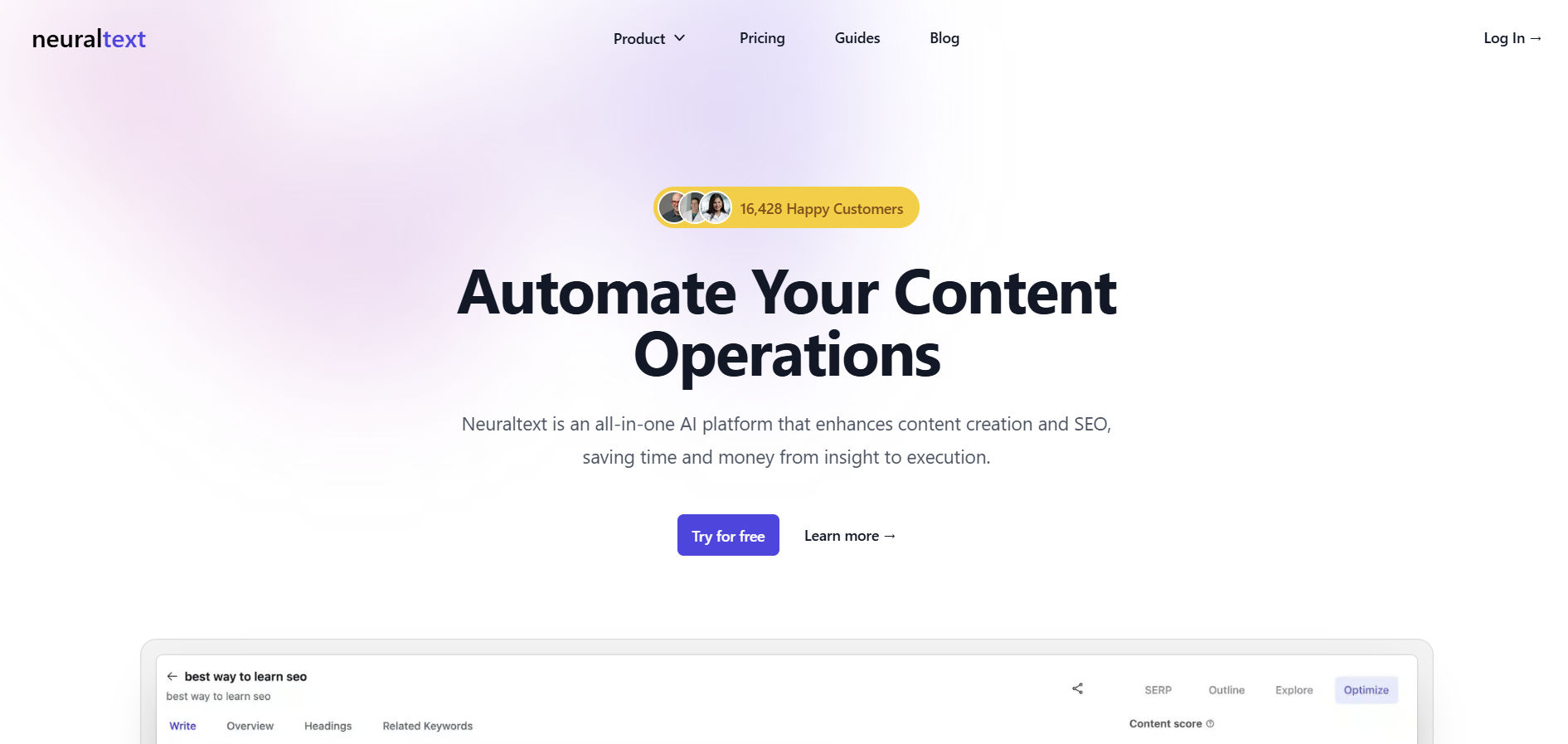
Neuraltext specializes in AI‑driven content research and outline generation. Its “Smart Topic” engine scrapes top‑ranking pages, extracts headings, and surfaces common questions in your niche. The AI writer then crafts paragraph drafts, complete with suggested stats and citations. NeuralText’s SEO module recommends related LSI keywords and tracks rank improvements. Marketers use it to speed up the research phase, while writers praise its accuracy in capturing search intent. Additionally, students can use Neuraltext to record lectures and automatically generate notes and flashcards, making it easier to create study materials.
Key Features
Neuraltext excels at research‑to‑draft workflows.
Smart Topic Extraction
AI Paragraph Builder
LSI Keyword Suggestions
Rank Tracking Dashboard
Pros & Cons
NeuralText streamlines research but collaboration features are basic.
Pros:
Comprehensive topic analysis
Data‑backed drafting
Built‑in rank tracker
Citation support
Cons:
Simplistic editing interface
No native version control
Limited team permissions
Occasional API timeouts
Who Should Use Neuraltext?
Research‑heavy content strategists
Solo bloggers
Small marketing teams
Data‑driven SEOs
3. Koala AI

Koala AI offers a modular AI writing suite that covers ideation, drafting, and editorial QA. The “Idea Generator” sparks headlines and angles based on audience inputs. Its editor features a “Quality Assurance” pass that flags passive voice, jargon, and grammar issues. Koala’s custom style guides enforce tone and terminology consistency. Integration with popular CMS and Slack notifications streamlines review cycles. Additionally, the Conch AI tool is an innovative solution for enhancing writing by switching words in essays and providing users with a revenue-sharing opportunity.
Key Features
Koala AI prioritizes editorial precision.
Headline & Angle Generator
AI QA Checker
Custom Style Guides
Slack & CMS Integrations
Pros & Cons
Koala AI is great for editorial control but less focused on SEO depth.
Pros:
Robust QA checks
Customizable brand guidelines
Headline ideation tool
Smooth Slack alerts
Cons:
Basic SEO features
Smaller template library
Collaboration limited to Slack
Premium features on higher plans
Who Should Use Koala AI?
Editorial teams
Corporate communications
PR agencies
Quality‑focused writers
4. Wordvice AI
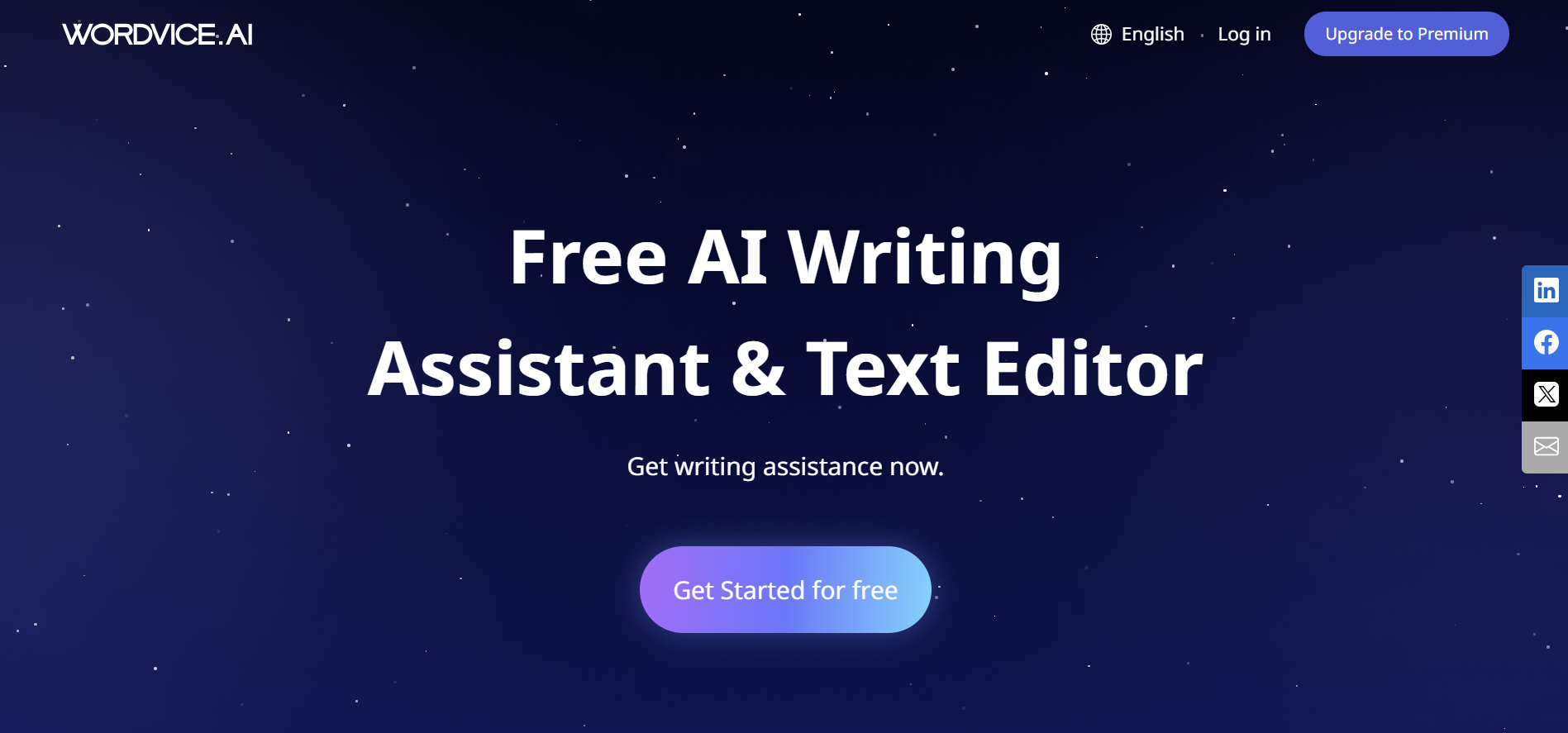
Wordvice AI merges AI rewriting with professional human editing services. After generating a draft, you can route it to in‑house editors or order paid review by language experts. The AI rewriting engine excels at improving clarity, conciseness, and tone, making it ideal for academic, medical, and technical writing that demands precision. Additionally, the platform features an interactive chat that allows users to ask questions and receive real-time assistance, enhancing the overall user experience.
Key Features
Wordvice AI bridges AI and human expertise.
AI Rewrite Engine
Pro Editing Marketplace
Citation & Reference Formatter
Clarity & Tone Adjustments
Pros & Cons
Wordvice AI offers high‑accuracy copy but at a higher cost.
Pros:
Human‑backed editing
Industry‑specific templates
Reference management
Tone‑tuning controls
Cons:
Higher per‑word fees for human edits
Slower turnaround with paid editing
Limited AI‑only templates
Less focus on SEO metrics
Who Should Use Wordvice AI?
Academic authors
Medical writers
Corporate white papers
Technical documentation teams
5. Brandwell AI
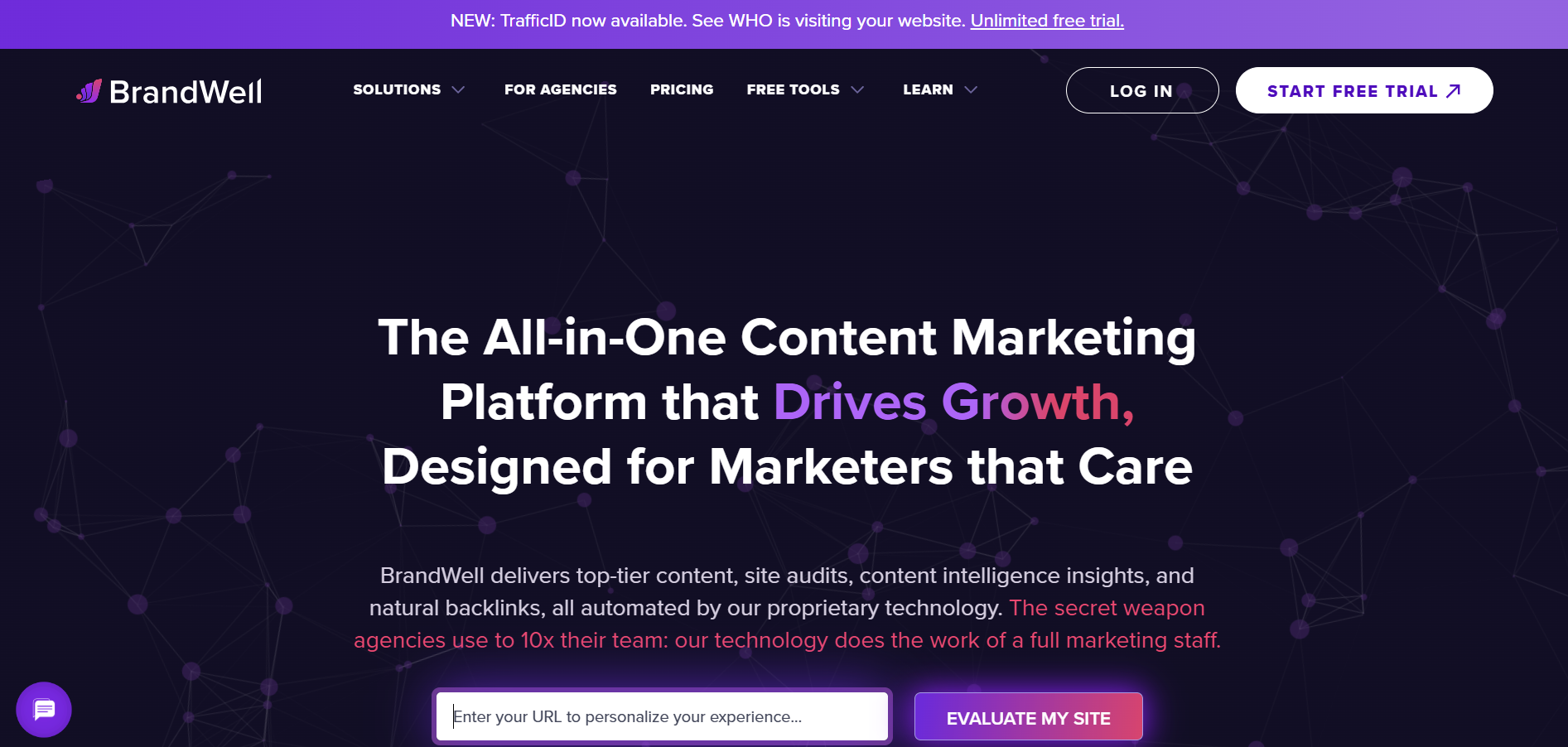
Brandwell AI positions itself as the “brand‑first” AI writer. You build a brand profile—values, voice pillars, keywords—and all AI drafts adhere to that. The platform includes a “Style Consistency” meter and brand analytics showing how well each piece matches your guidelines. Marketing teams use Brandwell AI to maintain a unified voice across campaigns and channels. Additionally, Brandwell AI allows users to upload various file types, such as documents and videos, for effective studying and analysis.
Key Features
Brandwell AI locks in brand consistency.
Brand Profile Setup
Style Consistency Meter
Voice Pillars Templates
Brand Analytics Dashboard
Pros & Cons
Brandwell AI enforces brand guidelines but lacks deep SEO tools.
Pros:
Strong brand alignment
Analytics on brand adherence
Custom voice templates
Easy onboarding
Cons:
Minimal SEO insights
Limited free tier
Fewer export options
No advanced grammar checks
Who Should Use Brandwell AI?
Large enterprises
Brand agencies
Multi‑channel marketers
Franchise communications
6. Seo AI

Seo AI delivers AI‑powered SEO analysis and content suggestions to elevate your on‑page optimization. The platform crawls top‑ranking results, extracts key topics, and recommends headings, keywords, and internal links that align with user intent. Its “Content Brief” generator compiles competitor insights into a structured outline, while the AI writer drafts paragraphs infused with your target terms.
Real‑time rank tracking and SERP feature alerts keep you informed of algorithm shifts. Marketing teams leverage Seo AI to produce search‑optimized articles at scale, cutting research time in half and improving keyword coverage consistency.
Key Features
Seo AI focuses on data‑driven SEO insights and content creation.
SERP Intent Modeling
Content Brief Generator
AI Draft Suggestions
Real‑Time Rank Tracking
Pros & Cons
Seo AI excels at SEO depth but is less robust on collaboration.
Pros:
Deep competitor analysis
Automated content briefs
Live ranking alerts
Seamless keyword integration
Cons:
Basic editorial tools
Limited team‑work features
Higher cost for full feature set
Steep initial setup
Who Should Use Seo AI?
SEO Specialists: For detailed optimization workflows.
Content Strategists: To build data‑backed briefs.
Digital Agencies: Managing multiple client campaigns.
Freelance Writers: Seeking SEO guidance in one tool.
7. Frase
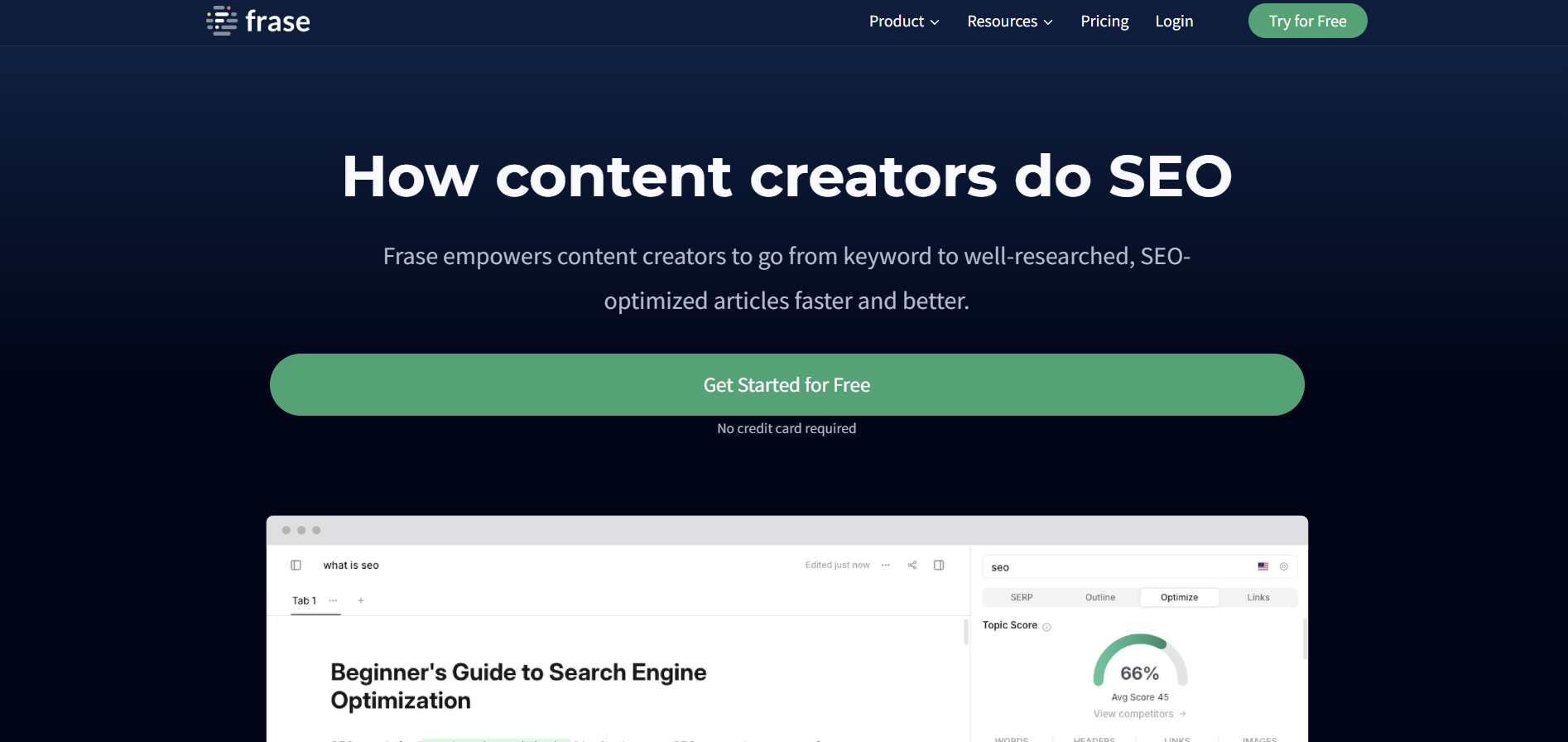
Frase combines AI‑driven content research with a robust writing assistant. Its “Research” module aggregates top results, extracts FAQs, and highlights common headings to create a comprehensive outline.
The AI writer then drafts sections that weave in these insights, ensuring topic coverage and relevance. Frase’s SEO and readability scorecards update in real time as you write. Teams use Frase to align content with search intent, boost on‑page SEO, and reduce back‑and‑forth between research and drafting. Additionally, Frase helps students improve their grades by enhancing writing quality and assisting in completing assignments effectively.
Key Features
Frase prioritizes research‑to‑draft efficiency and SEO alignment.
Automated Content Briefs
FAQ Extraction
AI Section Writer
SEO & Readability Scoring
Pros & Cons
Frase streamlines research but collaboration can be limited.
Pros:
Comprehensive briefs
FAQ‑based content ideas
Real‑time optimization feedback
Intuitive interface
Cons:
Collaboration confined to comments
Templates require manual tweaking
No built‑in CMS publishing
Higher tier for advanced analytics
Who Should Use Frase?
Content Researchers: For fast topic analysis.
SEO‑Focused Writers: To match search intent.
Marketing Teams: Streamlining briefing to writing.
Small Agencies: Needing all‑in‑one research tool.
8. Outwrite

Outwrite specializes in AI‑powered proofreading, rewriting, and style improvement. Its “Rewrite” feature enhances clarity, conciseness, and tone. The grammar checker flags passive voice, wordiness, and punctuation errors. Premium plans include a plagiarism detector and vocabulary suggestions.
Writers and editors use Outwrite to polish drafts generated by any AI tool or written manually, ensuring professional‑grade language and error‑free copy before publication. Additionally, Outwrite's AI-driven tools help users write faster, boosting productivity and efficiency.
Key Features
Outwrite focuses on editorial accuracy and style refinement.
AI Rewrite Engine
Grammar & Punctuation Checker
Plagiarism Detection
Vocabulary Enhancement
Pros & Cons
Outwrite shines in language quality but lacks full drafting tools.
Pros:
Advanced grammar checks
Tone and clarity improvements
Integrated plagiarism scanner
User‑friendly reports
Cons:
No outline generation
Limited SEO insights
Subscription required for plagiarism
Basic collaboration features
Who Should Use Outwrite?
Editors & Proofreaders: For final polish.
Academic Writers: Ensuring originality and correctness.
Non‑Native English Authors: Improving fluency.
Corporate Teams: Maintaining professional tone.
9. Junia AI
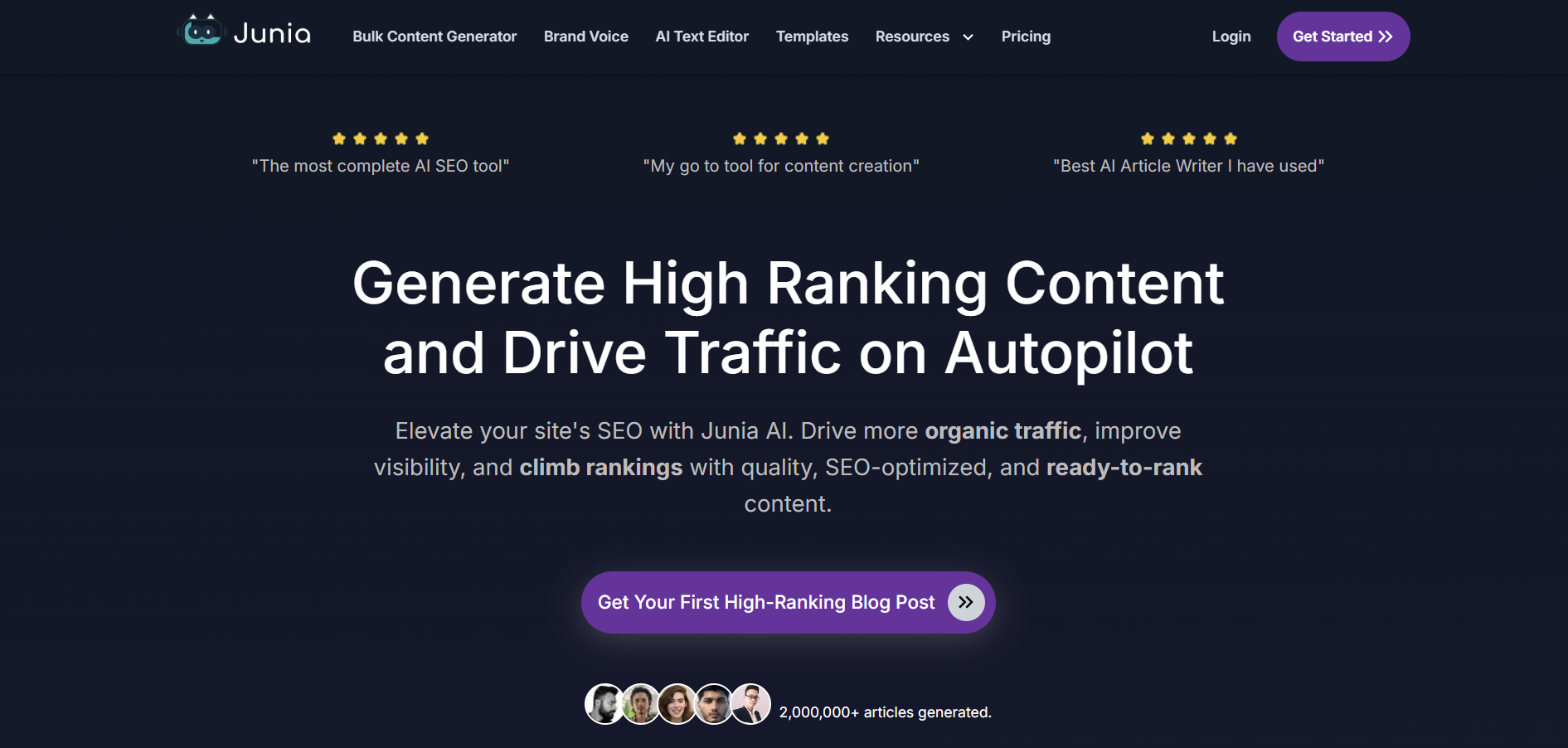
Junia AI offers an AI‑first writing platform with adaptive templates for blogs, emails, and social posts. Its “Smart Templates” guide you through best‑practice structures, while the AI assistant fills in sections based on minimal prompts. Junia AI supports a wide range of languages, making it versatile for users with diverse linguistic needs. Junia’s analytics dashboard reports engagement predictions and headline A/B tests. Content managers appreciate Junia AI for its ease of use and built‑in performance forecasting, which informs iterative improvements in real time.
Key Features
Junia AI blends template guidance with AI drafting and analytics.
Adaptive Smart Templates
AI Fill‑in Assistant
Engagement Prediction
Headline A/B Testing
Pros & Cons
Junia AI simplifies quick content creation but is lighter on SEO tools.
Pros:
Guided template workflows
Predictive performance insights
Fast social post generation
Built‑in A/B headline tests
Cons:
Limited deep SEO analysis
Smaller knowledge base
No advanced rewriting
Pricing scales with usage
Who Should Use Junia AI?
Social Media Managers: For rapid post creation.
Email Marketers: Leveraging template workflows.
Small Teams: Needing quick-turn content.
Performance‑Driven Content Creators: With A/B testing focus.
10. Scalenut
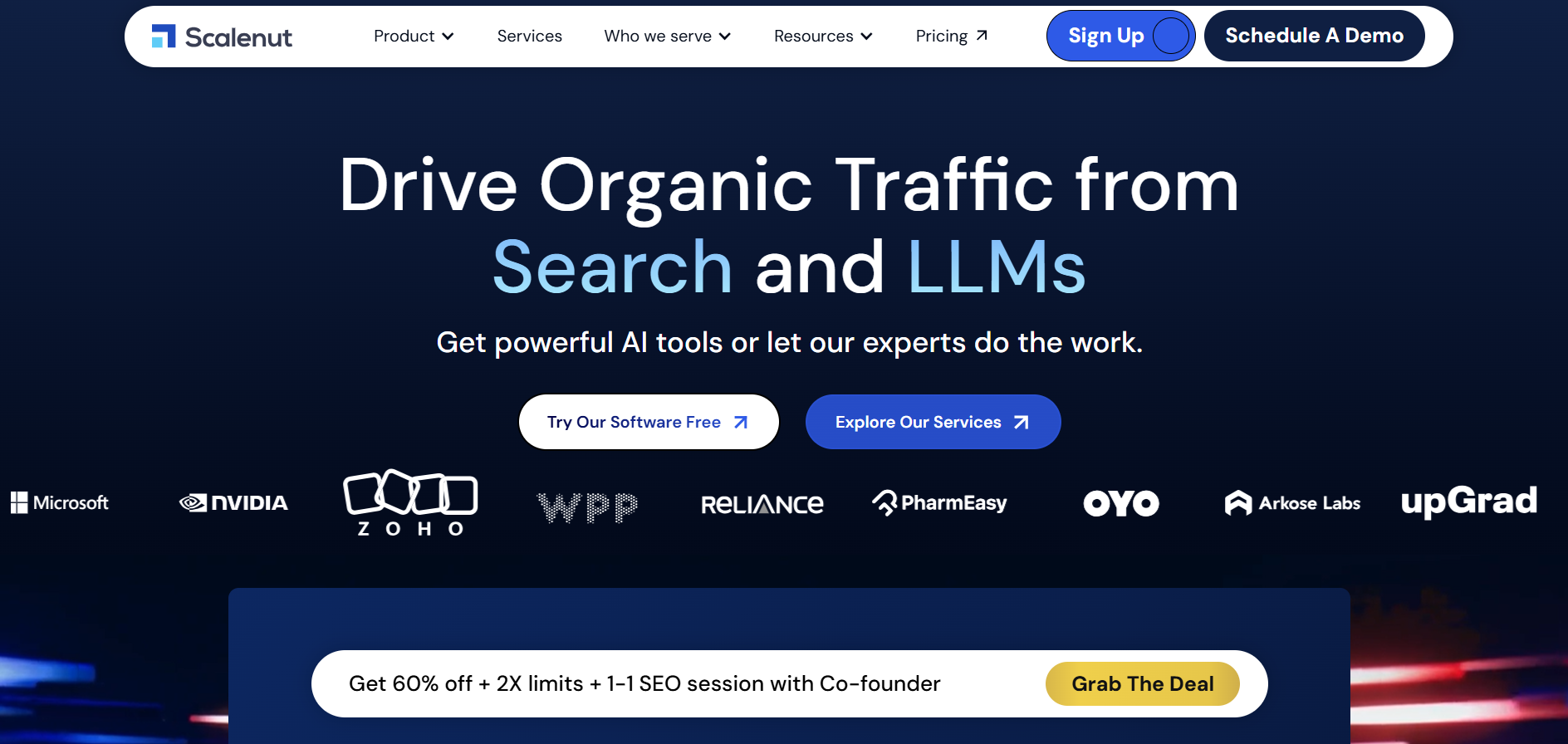
Scalenut delivers an end‑to‑end AI writing platform with strong emphasis on SEO research and long‑form content. Its “Topic Clusters” feature maps related subtopics, and the AI writer weaves them into cohesive drafts. Scalenut’s “Research” tab surfaces competitor headings, question gaps, and backlink opportunities.
The integrated “Writer” and “Editor” modules allow you to draft, revise, and optimize without leaving the ecosystem. Enterprises and agencies use Scalenut to scale content operations with consistent quality and SEO performance. Sign up to access these powerful tools and enhance your learning and writing experience.
Key Features
Scalenut focuses on SEO research and long‑form scaling.
Topic Cluster Mapping
Competitor Gap Analysis
AI Long‑Form Drafting
In‑Platform Editing & Optimization
Pros & Cons
Scalenut excels at scale but may overwhelm solo users.
Pros:
Robust SEO research tools
Seamless draft to optimize workflow
Backlink and gap analysis
Enterprise collaboration features
Cons:
Complex for small teams
Higher enterprise pricing
Learning curve for full feature use
No external integrations in lower tiers
Who Should Use Scalenut?
Large Agencies: Managing high‑volume content.
Enterprise SEO Teams: For deep research and scale.
In‑House Content Operations: Needing end‑to‑end tools.
Growth Marketers: Focused on organic traffic growth.
AI Writing Workflow Optimization
Optimizing the AI writing workflow is crucial to getting the most out of AI writing tools. This involves understanding how to use AI tools effectively, customizing the workflow to suit individual needs, and leveraging features like AI detection to ensure originality. By optimizing the AI writing workflow, writers can improve the quality of their content, increase productivity, and reduce the risk of plagiarism. Conch AI offers a range of features to help writers optimize their workflow, including a Chrome extension, writing assistant, and detection tools. These features allow for seamless integration into existing writing processes, making it easier to produce high-quality content consistently.
FAQs On Scalenut Alternatives
1. Which alternative is best for deep SEO analysis?
Seo AI and Scalenut offer the most comprehensive SEO research, competitor gap analysis, and real‑time ranking insights.
2. Are there free or trial options available?
Many platforms—including Inkforall, Outwrite, and Frase—offer limited free tiers or trial periods to test core features before upgrading. Additionally, free conch AI tools are highly beneficial and versatile, enhancing content quality while effectively bypassing AI detection, making them essential for writers seeking a human touch in their AI-assisted writing.
3. Which tool provides the strongest collaboration Features
Getconch AI itself and Scalenut lead in collaborative editing, version control, and role‑based permissions. Additionally, the versatility and effectiveness of tools that can rewrite text enhance readability and tailor content to specific audiences.
4. What is the most budget‑friendly solution?
Inkforall’s pay‑as‑you‑go billing and Outwrite’s free tier make them highly accessible for freelancers and small teams.
5. Which platform is best for non‑native English writers?
Outwrite and Wordvice AI excel in grammar checks, style guides, and clarity improvements, ideal for non‑native authors. Additionally, the significance of customizable and accessible study materials cannot be overstated, as they enhance personalization and facilitate efficient learning.